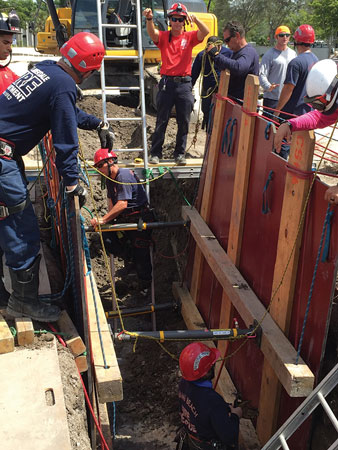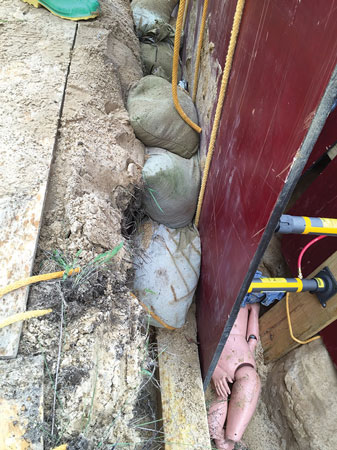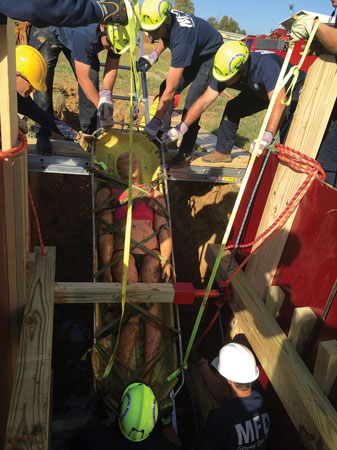
By JEREMY RIFFLARD
Trench rescue is one of the least common technical rescues. Many teams do not include this discipline in their response profile because of the low frequency of trench rescue calls, the cost of training and lumber, and the inability to transport the heavy lumber components.
National Fire Protection Association 1670, Standard on Operations and Training for Technical Search and Rescue Incidents, outlines the skills, knowledge, and abilities needed for awareness-, operations-, and technician-level training for trench rescue. To simplify the very basics of a trench rescue, panels are put in place to hold back soil, and shores are installed to keep the panels in position. This “box” creates a safe area where rescuers can work. If your team is going to train and respond to trench rescue calls, following are three essentials that can make the rescue easier.
#1: Sandbags
After you install the trench panels, stabilize them with wood, pneumatic, or hydraulic shores. Next, place the shores in between the trench panels. When the shores are pressurized, they will push against the trench panels. If the trench wall behind that panel has collapsed, there will be an area that is missing soil. There must be resistance behind the panel to stabilize the shores. So, add some sort of backfill behind the panels to create resistance.
For large gaps behind the outside of the trench panels, you can lower six- × six-inch wales into place (photo 1). Another substitution you can use is a ground ladder. The downside of using a ground ladder is that the ladder may be damaged from the pressure applied from the shores. So, use low-pressure air bags behind the panels to take up gaps; you can lower the air bags into position and inflate them to take up a four-foot-diameter space.
 |
| (1) A trench rescue wale operation using pneumatic shores. (Photos by author.) |
You can fill small gaps behind a trench panel with lumber, rock, or soil. Soil is the most common material used because it is readily available on most sites. Rescuers use shovels to place soil behind the trench panel. Because of the loose characteristics of soil, it tends to run out the side of the panel or underneath, where the strong back (two- × 12-inch lumber) extends below the panel. Rescuers can try to prevent the runoff by stuffing plywood or two-inch × four-inch × eight-foot boards along the edge of the panel. However, if the soil slough is large enough, this technique may not work.
An inexpensive way to keep the soil from running under the trench panels is to place the soil in sandbags (photo 2). Sandbags are inexpensive, are compact, and can be filled on scene. This device is self-explanatory and needs minimal guidance to install. Because of the low cost of sandbags, they do not need to be retrieved when you remove equipment from the trench. Most sandbags are biodegradable and can be buried in the trench after you have completed the rescue.
#2: Duct Tape
Pneumatic shores have some advantages over wood shores. With proper training, you can install and pressurize pneumatics more quickly. You can also pressurize pneumatics from outside the trench, which keeps rescuers out of the trench until the panels are secure. These shores have a collar that you must tighten to prevent the shores from retracting. Two types of threads are used with pneumatic shores. If you use the most common Acme thread, spin the collar until it is snug. Do this by sending a rescuer into the trench, but it can also be done safely from outside the trench by using duct tape.
 |
| (2) Sandbags are placed behind the panel as backfill; they can contain soil to prevent it from running under trench panels. |
To tighten the collar from outside, purchase a manufactured tool that bites into the collar and then can be turned. If the rescuers did not purchase this tool, they may try to tighten the collar with the tip of a pike pole or a two-inch × four-inch × eight-foot board of lumber. Note that lining up the lumber with the groove in the pneumatic shore is very challenging.
While teaching in South Carolina, I found a team that uses a device from a modified aluminum pool extension pole that normally has a skimmer net on the end. That team uses the pole without the net, and during the trench call, members reverse-wrap duct tape at the end of the pole; this puts the sticky side of the duct tape on the outside. After they pressure a shore, they extend the aluminum pole into the trench. The duct tape has just enough grip to hold the collar as you turn the pole to tighten it.
#3: Ladder Slide
When a trapped conscious person is free from the soil or rock that has kept him in the trench for some time, he is anxious to exit the trench. In most cases, that person will climb a ladder as quickly as possible. He may not want any assistance. If the victim is dehydrated, injured, or unconscious, then you will need to package him for removal.
If you are using a stokes basket or lifting harness to extract the victim, most teams will look for a high-point anchor to rig the haul system. This is an effective technique for removing the patient. It may take a little skill in rope rigging and using tag lines to effect the rescue. A ladder slide technique is quick and a little lower tech than other options. Often, “simple” is a better option.
 |
| (3) The ladder slide is a simple and fast technique to secure the victim and slide him out of the trench. |
You can package the patient in a device such as an extrication lift harness or a stokes basket. Place a ladder on an angle to the bottom of the trench next to the trench panels, and clear the area near the ladder of any trip hazards. Next, place the packaged patient on the lower portion of the ladder. I like to wrap a short webbing onto the ladder rung just higher than the position of the patient. Use a carabiner to attach the patient to the webbing you placed on the ladder.
On command of the team leader, two or three people outside of the trench will hand-haul the ladder upward and tilt it horizontally as the lower portion of the ladder is clear of the trench (photo 3). A rescuer inside the trench can assist lifting the ladder from this position; this lift and tilt should be done slowly to ensure the patient does not shift off the side of the ladder.
You can use many techniques to execute a trench rescue. Safety should always be paramount in any technique you choose. Efficiency comes from repetition of a skill. Practice the basic trench rescue skills whenever the opportunity arises. You can practice many individual skills having an actual trench available.
JEREMY RIFFLARD is a certified 25-year firefighter for the state of Florida and a captain with the Fort Lauderdale (FL) Fire Department (FLFD), an officer for FLFD’s technical rescue team, and a rescue squad officer of the Federal Emergency Management Agency’s Urban Search and Rescue team, FL-TF2. Rifflard’s most recent task force deployments include the 2010 Haiti earthquake and 2008’s Hurricane Ike. Rifflard teaches technical rescue programs for the Coral Springs (FL) Institute of Public Safety. For the past 15 years, he has been an instructor and a safety officer for Military Urban Search and Rescue exercises.
TRENCH RESCUE : MANAGING THE LOGISTICS FUNCTION
TRENCH RESCUE :THE BASICS
TRENCH RESCUE LESSONS LEARNED
Fire Engineering Archives

